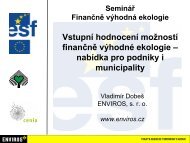Environmental Technologies and Eco-innovation in the Czech ...
Environmental Technologies and Eco-innovation in the Czech ...
Environmental Technologies and Eco-innovation in the Czech ...
Create successful ePaper yourself
Turn your PDF publications into a flip-book with our unique Google optimized e-Paper software.
2.1 | Fuel cells <strong>and</strong> hydrogenous power eng<strong>in</strong>eer<strong>in</strong>g<br />
Fuel cells are any electrochemical devices that produces electricity. They allow for<br />
a more effective <strong>and</strong> flexible use of fuels, <strong>in</strong>clud<strong>in</strong>g natural gas, biogas, hydrogen <strong>and</strong><br />
methanol. They are supposed to be used ma<strong>in</strong>ly <strong>in</strong> transport <strong>and</strong> power eng<strong>in</strong>eer<strong>in</strong>g,<br />
where <strong>the</strong>y could replace classical combustion eng<strong>in</strong>es. Fuel cells can serve as st<strong>and</strong>by<br />
units <strong>in</strong> hospitals, army equipment <strong>and</strong> remote locations.<br />
Be<strong>in</strong>g based on actual predictions, fuel cells us<strong>in</strong>g gas from gasified coal will play<br />
a key role <strong>in</strong> power eng<strong>in</strong>eer<strong>in</strong>g <strong>in</strong> <strong>the</strong> future. The forecasts stem from <strong>the</strong>se sources<br />
be<strong>in</strong>g 60% more efficient <strong>and</strong> hav<strong>in</strong>g only 10% of <strong>the</strong> emissions of currently used<br />
technologies, plus <strong>the</strong> possibility of CO 2 capture <strong>and</strong> disposal <strong>in</strong> accordance with <strong>the</strong><br />
technologies be<strong>in</strong>g newly developed (see Chapter 2.5 – Technology for CO 2 capture <strong>and</strong><br />
storage). The development <strong>and</strong> implementation of this technology already exists <strong>in</strong><br />
<strong>the</strong> first quarter of <strong>the</strong> 21 st century. In <strong>the</strong> <strong>Czech</strong> Republic, fuel cells are be<strong>in</strong>g developed<br />
<strong>and</strong> tested at universities. Examples <strong>in</strong>clude <strong>the</strong> Faculty of Electrical Eng<strong>in</strong>eer<strong>in</strong>g of<br />
CTU, <strong>the</strong> Department of Inorganic Technology of <strong>the</strong> Institute of Chemical Technology<br />
<strong>and</strong> elsewhere.<br />
Changes to hydrogen power eng<strong>in</strong>eer<strong>in</strong>g, which could help resolve <strong>the</strong> problem<br />
with <strong>the</strong> storage of electricity <strong>and</strong> heat, is be<strong>in</strong>g studied <strong>in</strong>tensively. However, today<br />
it is just a vision, not a commercially available solution.<br />
2.2 | Electricity generation from renewable energy sources<br />
One of <strong>the</strong> first <strong>in</strong>dicative obligations of <strong>the</strong> <strong>Czech</strong> Republic <strong>in</strong> <strong>the</strong> Treaty of Accession<br />
to <strong>the</strong> EU of 2004 was to specify a share of electricity generation from renewable energy<br />
sources <strong>in</strong> <strong>the</strong> total gross consumption of <strong>the</strong> <strong>Czech</strong> Republic at an amount of 8% by<br />
2010. At <strong>the</strong> end of 2007, this proportion was 4.74%. It is evident that <strong>the</strong> <strong>Czech</strong><br />
Republic focuses its attention <strong>and</strong> support on RES. The ma<strong>in</strong> reason for support<strong>in</strong>g<br />
energy generation from RES is its significance for reach<strong>in</strong>g <strong>the</strong> susta<strong>in</strong>able development<br />
of energy. Table No. 2 shows a summary of electricity generation from RES.<br />
32 | 33
















